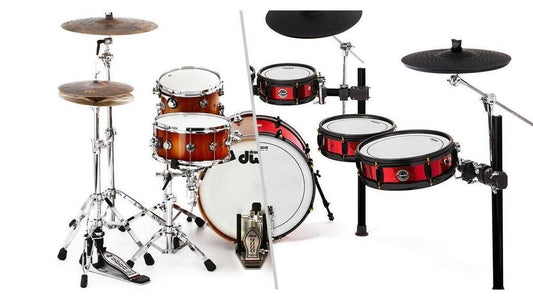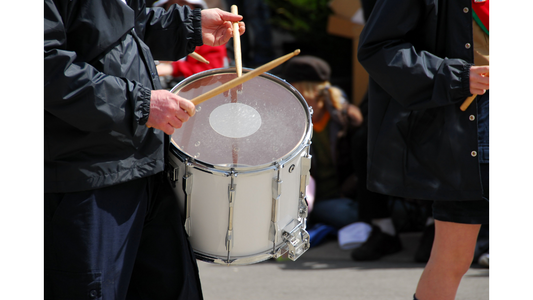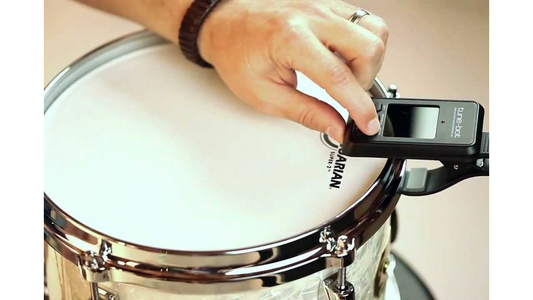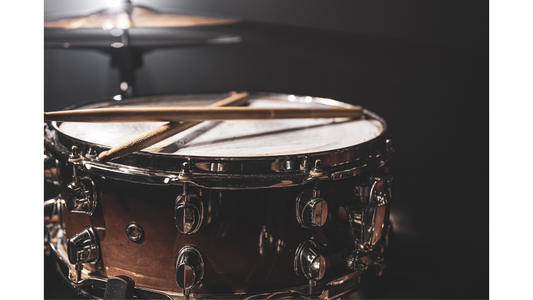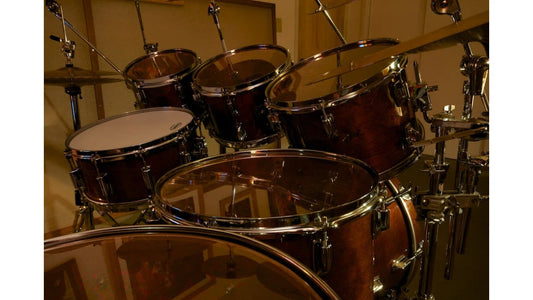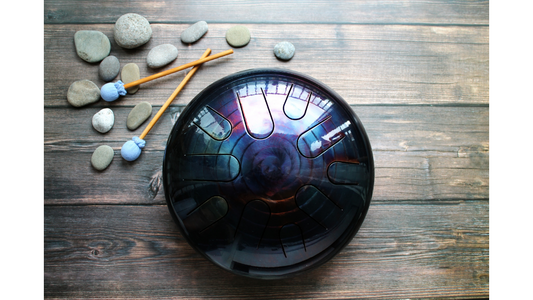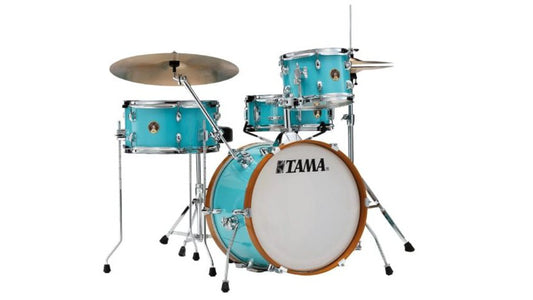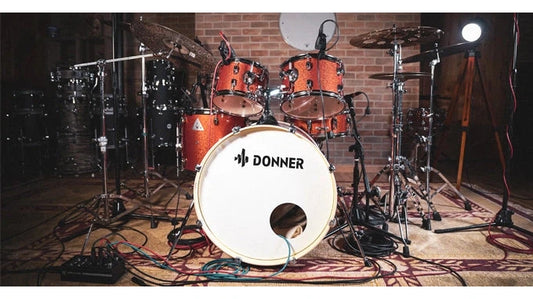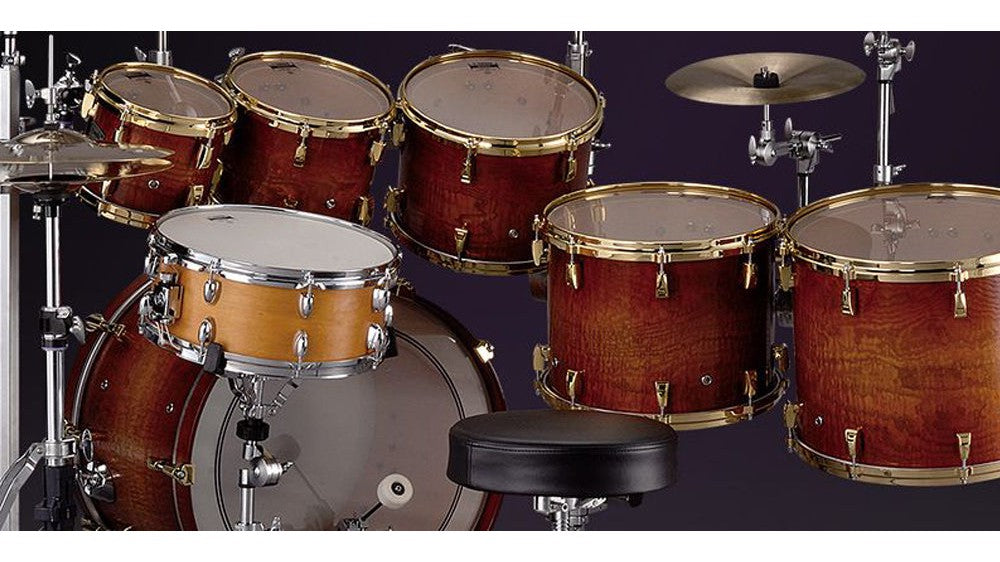
TRỐNG TOÀN TẬP - Phần 3: Trống Tom
Trong hai phần trước của loạt bài viết TRỐNG TOÀN TẬP, chúng ta đã hiểu về Trống Snare (Phần 1) và Trống Bass (Phần 2). Trong bài này, chúng ta sẽ bàn tới các Tom, ban đầu được coi là một hiệu ứng âm thanh nhưng hiện là thành phần thiết yếu của mọi bộ trống.
Ban đầu được gọi là tom-tom, Tom là một loại trống đơn giản không yêu cầu các cơ cấu bổ sung như trống Snare hoặc Foot Pedal. Hầu hết các bộ trống đều có tối đa một trống Snare và một trống Bass (đôi khi là hai), nhưng có thể có bất kỳ số trống Tom nào với các kích cỡ khác nhau. Tom có thể được sử dụng để chơi phụ, thêm màu cho giai điệu, hoặc thậm chí thay thế cho Hi-hat.
LỊCH SỬ TRỐNG TOM
Những chiếc trống đầu tiên xuất hiện tại châu Á vào cuối những năm 1800, được gọi là "tom-toms của Trung Quốc" được làm từ vỏ gỗ đơn giản. Đường kính dao động 20cm tới 35cm, với độ sâu chỉ chừng 10cm. Những trống này không thể được điều chỉnh vì không có vòng hoặc thanh điều chỉnh. Những tấm da (thường được sơn trang trí cầu kỳ) được dán đơn giản vào phần trên và dưới của vỏ.
Khi bộ trống hiện đại bắt đầu hình thành vào đầu những năm 1900, các nhà sản xuất trống của Mỹ đã nhập khẩu những bộ trống này, đặt theo thương hiệu của họ và đưa vào làm một phần của giàn trống. Đôi khi các Tom được gắn vào vòng đệm trống Bass, và đôi khi chúng chỉ đơn giản được đặt trên một "bàn hiệu ứng" (một chiếc bàn được đặt nhiều hiệu ứng bộ gõ khác nhau). Các Tom lớn hơn được hỗ trợ bằng cách sử dụng giá đỡ ba chân. Mãi đến năm 1940, giá ba chân mới được thay thế bằng chân kim loại thẳng, có thể điều chỉnh được gắn vào vỏ. Tom với kiểu gắn kết đó được gọi là Tom "sàn".
Vào những năm 1920, các tay trống bắt đầu sử dụng các Tom sâu hơn thường được gắn trên trống Bass (qua đường ray), và những trống đó có lớp hoàn thiện bên ngoài thường phù hợp với mặt trống Snare và trống Bass. Khi đó, các đầu trên có thể được điều chỉnh, nhưng các đầu dưới vẫn bị dính và không thể điều chỉnh được. Đây là một vấn đề lớn vì đầu được làm từ da bê hoặc da động vật và rất dễ bị thay đổi nhiệt độ và độ ẩm. Mãi cho đến cuối những năm 1950, đầu trống nhựa (làm bằng mylar, polyester hoặc hỗn hợp của cả hai) mới xuất hiện. Đây là một bước đột phá lớn vì các đầu nhựa giữ điều chỉnh của chúng ngay cả khi nhiệt độ và độ ẩm thay đổi.
"SING, SING, SING"
Tay trống huyền thoại Gene Krupa đã làm việc với các nhà sản xuất trống vào những năm 1930 để phát triển loại trống như chúng ta biết ngày nay. Krupa nhấn mạnh rằng đầu trên và đầu dưới cho các Tom của ông phải điều chỉnh được. Các Tom mang tính cách mạng này đã sử dụng vòng kim loại để giữ đầu, cùng với các thanh căng (có thể điều chỉnh bằng phím trống) để điều chỉnh. Buổi trình diễn trống của ông trong bản hit năm 1936 với tác phẩm “Sing, Sing, Sing” bao gồm những đoạn tom riff nổi tiếng nhất trong lịch sử âm nhạc. Krupa cũng giúp thiết lập một số kích thước Tom tiêu chuẩn hiện nay như 33cm x 23cm và 40cm x 40cm (đường kính x sâu).
HỆ THỐNG GIÁ ĐỠ
Vào cuối những năm 1950 và đầu những năm 1960, các hệ thống giá đỡ cho trống Tom đã phát triển từ đường ray thành dạng ống chắc chắn mà chúng ta thấy ngày nay. Khi nhạc rock trở nên phổ biến, các bộ trống có xu hướng lớn hơn, một số tay trống sử dụng các bộ bao gồm bốn Tom trở lên với các kích cỡ khác nhau. Tom có thể được gắn trên trống Bass, trên giá đỡ đặt trên sàn, hoặc - như trường hợp của Tom sàn - trên chân có giá đỡ gắn vào vỏ. Những điều này không chỉ làm cho việc cài đặt nhanh hơn và dễ dàng hơn, chúng còn làm giảm diện tích của bộ trống so với việc sử dụng các giá đỡ riêng biệt. Một lợi ích khác của việc sử dụng giá đỡ là một số tay trống thích âm thanh của trống Bass hơn khi các Tom không được gắn trực tiếp vào nó.
ĐƯỜNG KÍNH VÀ CHIỀU SÂU TRỐNG TOM:
Ngày nay, các đường kính tiêu chuẩn cho trống Tom là 20cm, 25cm, 30cm, 33cm và 36cm, trong khi Tom sàn thường được sản xuất với đường kính 36cm, 40cm, 45cm. Độ sâu của vỏ cũng có thể thay đổi: Độ sâu tiêu chuẩn là 20cm, 25cm, 33cm vaf640cm. Yamaha Absolute Hybrid Maple gắn các loại Tom có đường kính truyền thống, nhưng có thể được đặt hàng với độ sâu khác nhau một chút.
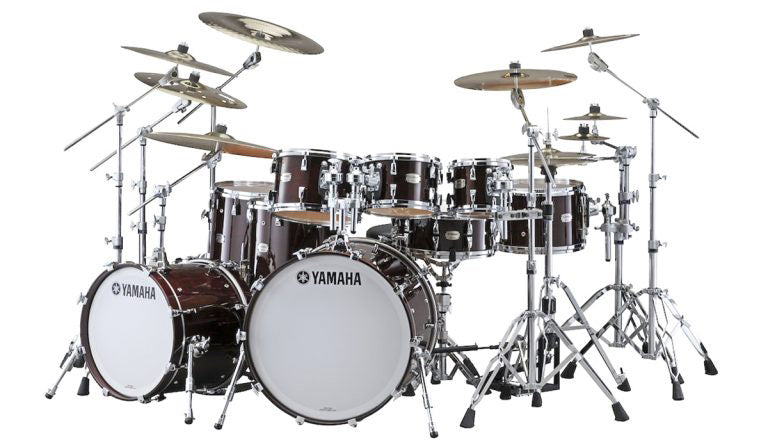
Yamaha Absolute Hybrid Maple toms có nhiều kích cỡ khác nhau.
Cũng như các loại trống khác, cao độ cơ bản của trống phụ thuộc vào đường kính và độ sâu của vỏ. Vỏ lớn hơn thường tạo ra âm vực thấp hơn. Các lớp vỏ nhỏ hơn cung cấp nhiều tiếng "snap" hơn và phản hồi nhanh hơn, trong khi lớp vỏ sâu hơn giúp tăng cường khả năng trình diễn, tạo ra nhiều âm bội hơn và tăng thêm trọng lượng cho âm thanh.
Không có quy tắc nào về kích thước tom cho các loại nhạc cụ thể. Nhiều tay trống jazz thích Tom 30cm x 20cm và 35cm x 35cm, trong khi bạn sẽ tìm thấy 33cm x 23cm và 40cm x 40cm hoặc 45cm x 40cm trong các giàn trống nhạc rock. Một bộ trống kết hợp thường có các kích thước nhỏ hơn như 25cm x 20cm và 30cm x 20cm và một Tom sàn 35cm x 35cm. Lớp da dưới đôi khi được loại bỏ (mặc dù thường được sử dụng để ghi âm hơn là biểu diễn trực tiếp) để có âm thanh to hơn và giai điệu cởi mở hơn với độ cộng hưởng ít hơn.
Có sẵn các loại Tom khác, chẳng hạn như Tom roto (có một đầu có thể điều chỉnh duy nhất trong khung kim loại mà không có bất kỳ vỏ nào) và Tom hòa nhạc cực lớn, có vỏ sâu hơn và không có đầu dưới. Chúng được thiết kế đặc biệt cho một dàn nhạc đầy đủ và thường không được khuyến khích sử dụng trong các bộ trống, mặc dù chúng đã được sử dụng bởi một số tay trống rock trong những năm 70 và 80.
VẬT LIỆU DÙNG CHO TRỐNG TOM
Vỏ Tom có thể được làm từ sợi thủy tinh, acrylic và đôi khi là thép không gỉ, nhưng gỗ vẫn là vật liệu phổ biến nhất cho đến nay. Vỏ gỗ thường được làm từ nhiều mảnh gỗ như sồi, bạch dương hoặc phong (oak, birch or maple).
Gỗ sồi được sử dụng trong trống Tom Yamaha Live Custom Hybrid Oak. Loại gỗ này tạo ra giai điệu tròn, âm cao êm dịu và âm thấp ấm áp. Vỏ của trống được làm từ gỗ sồi bao quanh một lớp phenolic dày đặc. Thiết kế của vỏ Live Custom Hybrid Oak nhấn mạnh sức tấn công đồng thời tăng phạm vi động của trống.
Yamaha Recording Custom và Stage Custom Birch toms được sản xuất từ gỗ bạch dương. Bạch dương thể hiện đặc biệt tốt, giúp âm thanh của trống xuyên suốt hỗn hợp. Nó tạo ra âm sắc tươi sáng, sống động với sự nhấn mạnh ở các tần số thấp và cao, và các tần số trung bình được giảm nhẹ.
Maple là một trong những loại gỗ phổ biến nhất để làm vỏ trống và được sử dụng trong trống Tom Yamaha Absolute Hybrid Maple và Tour Custom. Vỏ phong mang đến âm trầm ấm áp, tần số trung được tăng cường nhẹ và tần số thấp và cao cân bằng. Vỏ trống Absolute Hybrid Maple kết hợp các tấm gỗ thích với một lớp gỗ bên trong - một loại gỗ cứng và nặng kết hợp với một loại gỗ phong để tạo ra âm thanh phong phú, rõ ràng ở nhiều mức âm lượng khác nhau. Vỏ trống của Yamaha PHX (“phoenix”) được làm từ các tấm gỗ jatoba, kapur và gỗ phong Bắc Mỹ. Cấu trúc độc đáo này tối đa hóa hiệu suất và tăng độ rung của đầu trống.
TỐI ĐA HÓA CỘNG HƯỞNG
Tom được thiết kế để cộng hưởng, nhưng đôi khi phần cứng gắn vào vỏ có thể làm giảm sự cộng hưởng đó. Y.E.S.S. (Hệ thống duy trì tăng cường của Yamaha) I, II và III được trang bị trên tất cả các bộ trống của Yamaha (ngoại trừ các mẫu Stage Custom Hip và Rydeen) hoạt động như một hệ thống gắn chống sốc và giảm thiểu tiếp xúc giữa vỏ và ngàm, cho phép vỏ rung động tối đa - do đó, cộng hưởng tối đa.
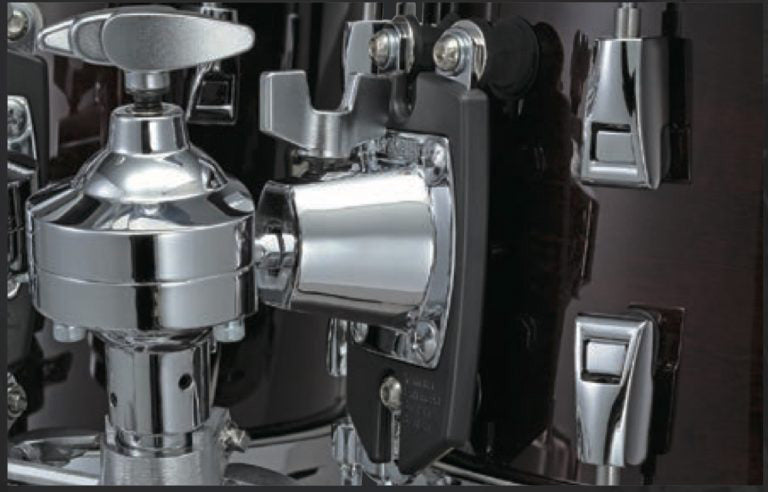
Yamaha Y.E.S.S. tom mount
Các chốt cũng có thể làm giảm độ cộng hưởng của vỏ và đó là lý do tại sao chốt Absolute có trên trống Tom Yamaha Tour Custom được thiết kế không chạm vào vỏ nhờ các miếng đệm cao su.
Một cách tiếp cận khác được thực hiện trống Tom PHX của Yamaha, sử dụng hệ thống chốt móc. Ở một số khu vực của vỏ tạo ra âm bội không mong muốn, các chốt móc này sẽ được gắn ở đó. Thiết kế này giúp tắt nhanh chóng các âm bội không mong muốn và tạo ra một chất âm thuần túy. Hệ thống chốt móc cũng giúp thay đổi đầu nhanh chóng và dễ dàng.
Tom cung cấp nhiều tùy chọn âm sắc cho bộ trống của bạn và cũng có thể giúp bạn chơi vui hơn. Hơn hết, bạn có thể bắt đầu chỉ với một hoặc hai Tom và thêm nhiều hơn nữa khi kỹ thuật của bạn đã sẵn sàng.
